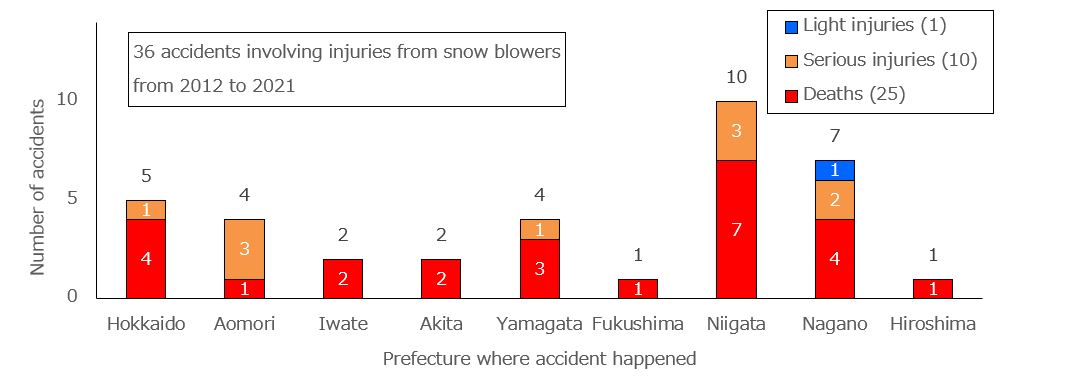- Home
- News Releases
- Back Issues
- December FY2022
- 70% of Snowblower Deaths Due to Misuse or Carelessness
70% of Snowblower Deaths Due to Misuse or Carelessness
-Turning safety features on and the engine off can decide life or death-
December 22, 2022
Joint Press Release with the Consumer Affairs Agency and National Institute of Technology and Evaluation
It is forecast that the amount of snowfall this winter may be higher than average, mainly along the coast of the Sea of Japan. Therefore, there will be a higher chance of snowblowers being used this year, and it is more important than ever to be cautious.
When handling a snowblower, be sure to take precautions such as keeping the safety features on and turning off the engine depending on the situation.
1. Overview
There have been 36 cases of injuries caused by snowblowers and 25 deaths, according to information on product-related accidents reported from FY2012 to FY2021*1 to NITE (National Institute of Technology and Evaluation).*2 In addition, 18 of the deaths (about 70%) were caused by the user using the snowblower incorrectly or being careless (e.g., accidentally disabling the safety features or slipping and falling).
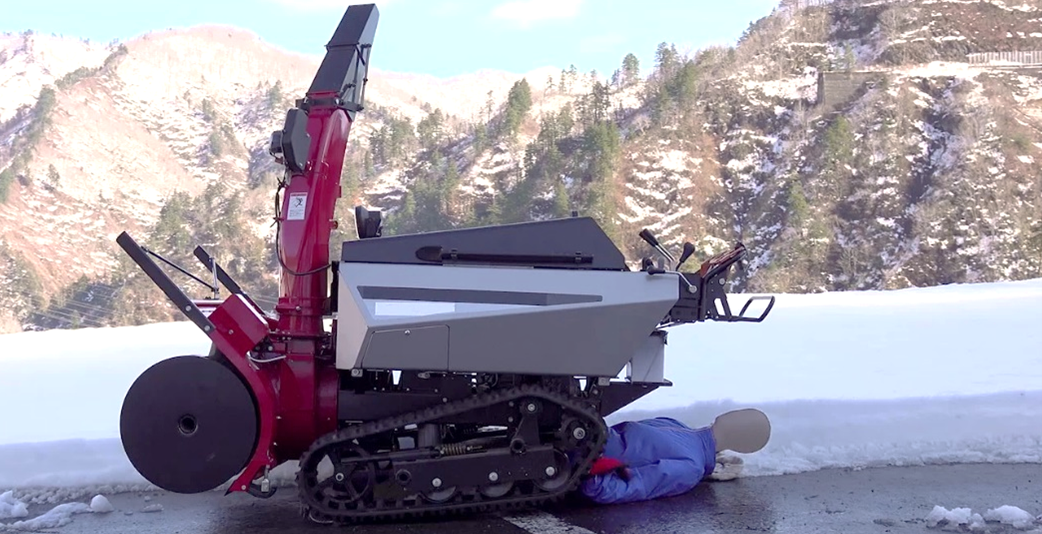
Accident in which the user uses the snowblower incorrectly and is trapped under it (reenactment)
Graph 1: Accidents caused by snowblowers by prefecture
Points of caution regarding snowblowers
- Do not disable safety features such as the dead man's clutch mechanism.
- When moving the snowblower in reverse, carefully observe your surroundings to prevent falling or being trapped.
- Use the snowblower when there are no people in the vicinity.
- Turn off the engine when leaving the area.
- When removing clogged snow, make sure the engine and rotating parts are stopped and use a snow removal tool.
- Use the snowblower outside in a well-ventilated area, including when starting or stopping it.
2. Snowblower structure and part names

Figure 1: Snowblower structure (courtesy of NITE)
Dead man's clutch mechanism (safety feature)
A safety feature that automatically stops the rotating parts and the snowblower's movement when the user releases the operating handle (clutch lever). This prevents the machine from operating when the user lets it go.
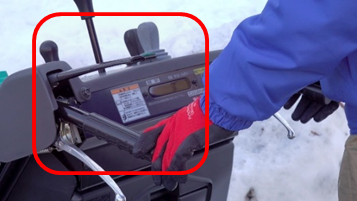
Figure 2: Dead man's clutch mechanism (safety feature) (courtesy of NITE)

3. Situation surrounding accidents
The number of accidents that happened each year is displayed in Graph 2. Snowblower accidents happen every year. There was one accident in FY2019, when there was a small amount of snowfall across the nation, 12 accidents in FY2020, when there was a large amount of snowfall in several areas. and three accidents in FY2021, when most areas had a normal amount of snowfall while some areas experienced slightly more snowfall than in the average year. This shows a tendency to more accidents when there is more snowfall creating more chances to use a snowblower. In addition, the three accidents in FY2021 resulted in death, and there continue to be accidents leading to serious injuries and deaths.
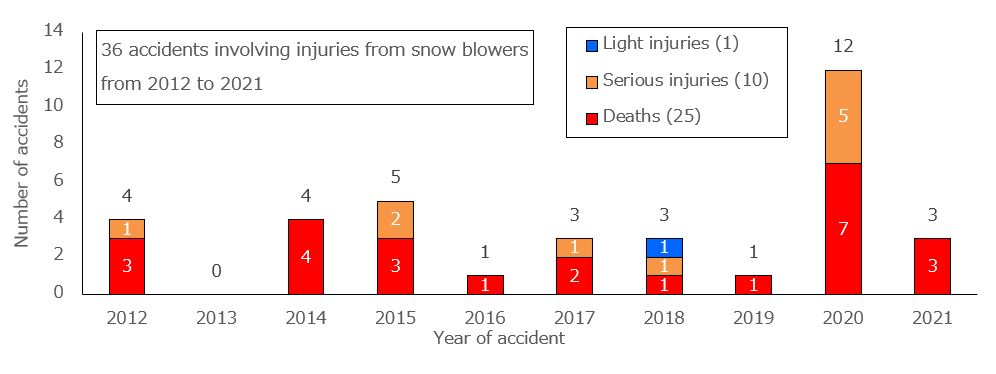
Graph 2: Number of accidents per year
Table 1 displays the 36 accidents involving injuries classified by scenario.
| Deaths | Serious injuries |
Light injuries |
Total | |
|---|---|---|---|---|
| Pinned under the snowblower | 16 | 16 | ||
| Caught in the auger | 6 | 1 | 7 | |
| Caught between a rear wall and snowblower | 3 | 1 | 4 | |
| Attempted to remove clogged snow | 8 | 8 | ||
| Hand was caught in the rotating parts during maintenance | 1 | 1 | ||
| Total | 25 | 10 | 1 | 36 |
Of the 36 accidents that resulted in an injury, 15 involved disabling or not using safety features.
Table 2 displays the 36 accidents involving injuries classified by cause. Excluding those under investigation, about 90% of them were caused by the user using the snowblower incorrectly or being careless.
Table 2: Number of accidents by cause (Values inside parentheses are the number of accidents resulting in death)
| Cause | Number of accidents |
|---|---|
| Accidents due to mishandling or carelessness | 29(18) |
| Accidents for which the cause cannot be identified | 3(3) |
| Under investigation | 4(4) |
| Total | 36(25) |
4. Examples of snowblower accidents
Accident: Pinned under the snowblower
Date: January 2021 (Hiroshima Prefecture, a male in his eighties, died)
[Accident description]
The user was pinned under the snowblower while it was in use. After being transported to the hospital, he was confirmed dead.
[Accident cause]
It is thought that the user fell while the snowblower was moving in reverse and the dead man's clutch was disabled, and the snowblower climbed on top of the user, pinning him underneath.
Accident: Caught in the snowblower while the engine was running
Date: January 2021 (Niigata Prefecture, 9yearold boy, died)
[Accident description]
While the snowblower was in use, a child was caught in the rotating parts (auger). After being transported to the hospital, he was confirmed dead.
[Accident cause]
It is thought that in the middle of snow removal, the user left the area without turning off the snowblower's engine, leaving the auger still rotating, and a child playing in the area touched the auger.
Accident: Caught in the auger
Date: February 2021 (Yamagata Prefecture, a male in his seventies, died)
[Accident description]
The user was found caught within the snowblower's auger. After being transported to the hospital, he was confirmed dead.
[Accident cause]
It is thought that the user left the snowblower's engine running and, without the emergency stop safety key attached to his body, approached the rotating auger, and his lower body was caught in it.
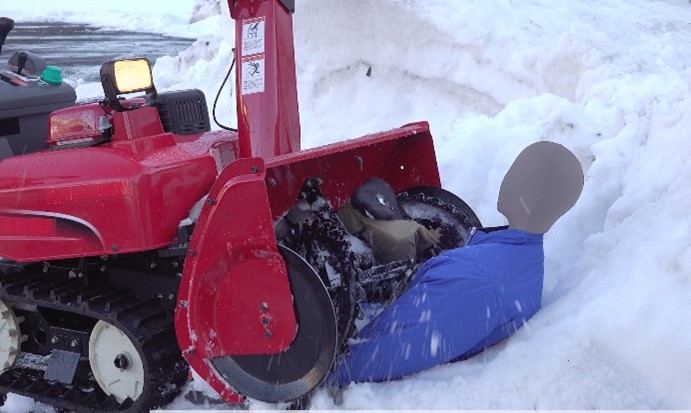
Accident involving being caught in the auger
Points of caution regarding snowblowers
Do not disable safety features such as the dead man's clutch mechanism
When safety features are disabled, there is a risk of the user being run over by or caught in the snowblower if they fall and the snowblower does not stop. Never disable the dead man's clutch mechanism (e.g., by fixing its clutch lever in place) or use the snowblower without the emergency stop safety key attached. It is extremely dangerous.
Some older snowblowers (released before April 2004) do not have safety features like dead man's clutches. These models must be used with even greater care. It is safer to use models with safety features such as emergency stop bars and buttons.

Points of caution regarding snowblowers
When moving the snowblower in reverse, carefully observe your surroundings to prevent falling or being trapped
It is extremely easy to slip when working on top of snow. Be careful not to fall. Especially be sure to check for obstructions when moving in reverse. If there is an obstruction, you could fall and get pulled in by or caught within the snowblower.
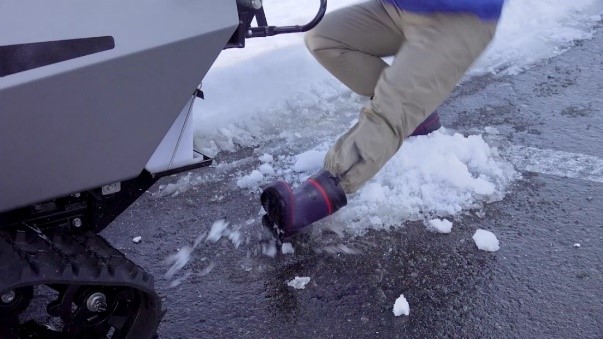
Use the snowblower when there are no people in the vicinity
Make sure the area where you are removing snow is safe and there are no people in the vicinity. Especially do not allow children to come close. Always make sure that there are also no people in the direction the snow is being blown.
Turn off the engine when leaving the area
Leaving the area with the snowblower's engine on can lead to an unexpected accident (e.g., by a child playing a prank). Always turn off the engine, even if you are leaving the are only temporarily.
Accident: Injured while attempting to remove clogged snow
Date: January 2021 (Hokkaido, a male in his twentieth, seriously injured)
[Accident description]
The user injured his right hand while trying to remove clogged snow from the blower.
[Accident cause]
The user removed clogged snow in the snowblower's blower directly by hand, not using the snow removal tool attached to the machine while the rotating parts are still running. The accident is thought to have been caused by the rotating blade inside the blower touching him.
Points of caution regarding snowblowers
When removing clogged snow, make sure the engine and rotating parts are stopped and use a snow removal tool
Keep your hands away from the chute and auger when the engine is running. Removing snow with the engine running may result in hand injuries. If snow becomes clogged, do not use your hands—use a snow removal tool attached to the machine to remove it.

Accident: Carbon monoxide poisoning caused by exhaust
Among the accidents reported to the Consumer Affairs Agency under the Consumer Safety Act, there were three caused by carbon monoxide poisoning, two of which resulted in death.
Date: November 2021 (Hokkaido, a female in her seventies, died)
[Accident description]
The user was found in a storage room leaning on a moving snow plow (walk behind type) and in cardiopulmonary arrest. After being transported to the hospital, it was confirmed that she had died of carbon monoxide poisoning.
Points of caution regarding snowblowers
Please use the snowblower outside in a well-ventilated area, including when starting or stopping it
Exhaust from a snowblower contains carbon monoxide. Carbon monoxide, a highly toxic gas, is colorless and odorless, making it difficult to notice. Using a product like a snowblower that runs with an engine in a closed indoors is extremely dangerous, as the carbon monoxide can become concentrated in a short time. Please use the snowblower outside in a well-ventilated area, including when starting or stopping it.
When using a snowblower that cannot be moved by hand while the engine is off (e.g., a large snowblower), open the windows or other openings, ensure there is enough ventilation, and take precautions, including the following:
- Start the snowblower, and immediately move it outside
- When it is parked inside, immediately turn off the engine
Reference
In addition to the Ministry of Economy, Trade and Industry, the Consumer Affairs Agency and the National Institute of Technology and Innovation (NITE) are issuing calls for attention related to snowblower accidents today.
- Consumer Affairs Agency 70% of Snowblower Deaths Due to Misuse or Carelessness -Turning safety features on and the engine off can decide life or death- (December 22, 2022)-

- National Institute of Technology and Innovation (NITE) 70% of Snowblower Deaths Due to Misuse or Carelessness -Turning safety features on and the engine off can decide life or death- (December 22, 2022)-

- JYOSETSUKI ANZEN KYOGIKAI, "Walk Behind Snowblower Safety Awareness Flyer"

Division in Charge
Product Accident Information and Analysis Office, Product Safety Division, Industrial and Product Safety Policy Group
